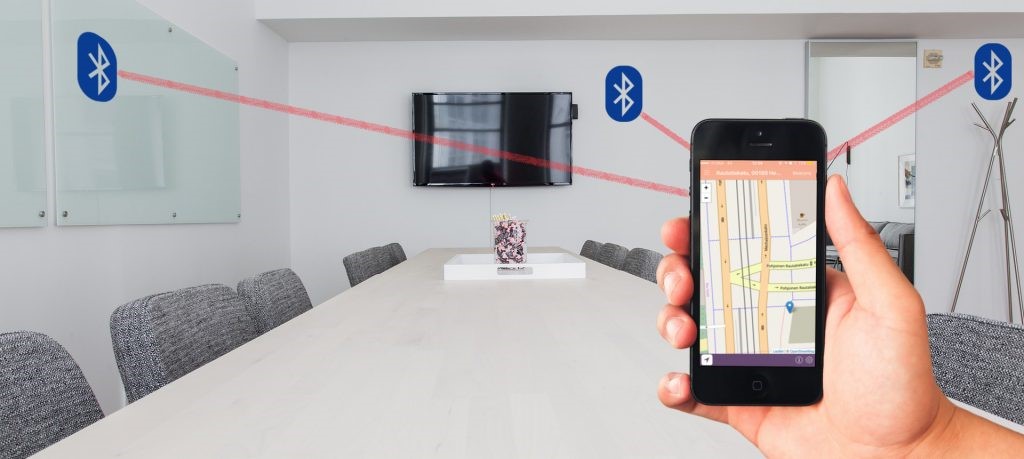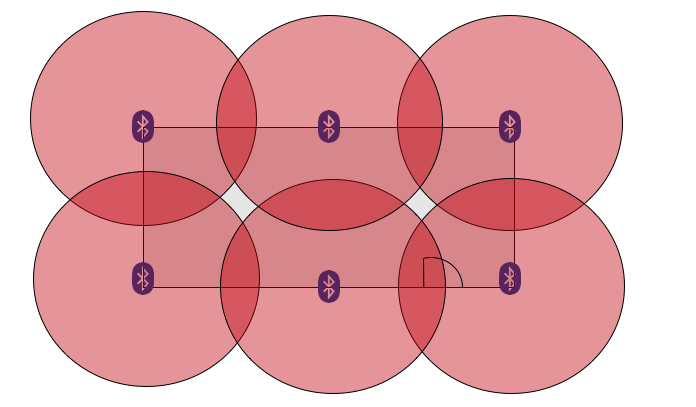Bluetooth beacon (beacon) is a small, simple and cost-effective way to establish a connection between a real device and a mobile application. Using beacons for push notifications, coupons and location detection is quite simple, but if you want to use beacons to create accurate indoor positioning, things will become more complicated. You need to consider beacon placement and positioning algorithms. However, if you pass professional. The deployment and preparation of the Bluetooth beacon can also achieve a positioning accuracy of 1-2 meters. How to use iBeacon for accurate indoor positioning?

Software based on iBeacon positioning
Determine the location of the beacon.
To obtain accurate positioning accuracy, you need to understand from the most basic knowledge. Bluetooth beacons do not have built-in location information. They are just like its name-they are like lighthouses that provide directions to nearby ships, only sending around the beacon. Bluetooth signal, it is expected that nearby smart devices can receive it and understand its meaning. Whether you are using iBeacon, Eddystone protocol or other protocols, your beacon will transmit its UUID, primary and secondary values or its namespace and instance ID. In order to convert these values into real-world coordinates, you need to assign physical coordinates for each beacon in the application's internal or external database. After comparing the received signal value with your registered beacon and its coordinates, you will be able to get the first rough position estimate through RSSI. RSSI stands for received signal strength indicator, which represents the power value of the received radio signal. The longer the distance, the lower the RSSI signal.
Trilateral measurement.
The second most important thing is that the beacon does not have a directional antenna-you can only receive an estimate of the distance to the beacon, not which direction the signal comes from. In order to understand this, you need to calculate with three or more beacons and compare the RSSI value with each beacon. When the beacon is well placed, the calculation will point you to a specific location in the room. As in theory, you do need at least three beacons to calculate the exact location. Of course, in narrow corridors or other situations, you can calculate the position between two beacons.
Kalman filter.
Unfortunately, even with the best beacon model, there are irregularities in the transmitted signal and may be affected by unwanted noise. Therefore, the common solution is to add a set of filters and algorithms on top of the trilateration calculation. In short, the Kalman filter is an algorithm that considers measurement history. Thereby verifying the signal.
Beacon equipment and location principles
Beacon selection.
Although there are many bluetooth beacon (beacon, iBeacon) manufacturers on the market, when choosing, you need to check the technical specifications, mainly considering two aspects: 1) signal stability; 2) battery life. As for the beacon protocol, the current mainstream positioning software supports iBeacon or Eddystone, and either or both of the beacon protocols can be supported in the beacon selection.
Beacon height.
To obtain the best positioning accuracy, the beacon should be placed on a wall about 2 meters high. This is because when the signal comes from above, your smart device is more likely to receive it. At the same time, place the beacon as far away as possible from iron or other obstacles to reduce interference caused by signal scattering, shielding, and diffraction.
Beacon layout.
When you plan to install the location of the beacon, please check the floor CAD drawing of the environment, it can help you measure the size of the room and calculate the number of Bluetooth beacons you need. First place a beacon at each corner of the room. If your square room is larger than the beacon signal range, you need to have more beacons between the corners to provide a positioning accuracy of 1-2 meters. When you use a room other than the square room, we recommend that you also check the floor map and plan the location of the beacon there. Ensure that the signal of the beacon does not cause self-interference. For example, if you set the transmission power equal to 30 meters, the preferred maximum distance is 20-25 meters to provide a more accurate location. Also make sure your room is big enough.
The following is an example of the location of a beacon in a square room. This photo represents a large room, and each corner needs more than one beacon.

If you need to locate in a larger space, or need an indoor-outdoor transition, for example, if you want to place a beacon in a store, please add one next to the entrance. This event will be triggered when a customer who has installed a smart device and your app is installed on it enters or exits your store. In addition, there are many other situations that need to be considered. If you need to accurately locate a multi-storey building, it is recommended that you add a beacon immediately after entering/exiting the stairs, escalators or elevators, otherwise your smart device will not be able to zone. The difference between the floors, which is why the beacon is placed immediately after the floor change occurs.
We also recommend that you prioritize the room and environment. Do you have some rooms that you may not need precise locations, such as toilets and storage facilities? If you have such a room, you can leave fewer beacons.
Expert tips! If you want to test whether the current beacon position can be trilaterally measured, just use a pen and paper to make a rough calculation based on the distance. If you cannot make a triangle between the beacons, it is likely that triangulation will not occur. Remember the signal strength and range of your beacon.
Beacon settings.
After placing the beacons, it is best to check their settings. The device manufacturer will send data with the default settings. In this case, you don't need to change these settings at all. Of course, the supplier will provide tools to configure the beacon.
In order to obtain better indoor positioning accuracy, it is recommended that the transmission power is usually set to about -4db, and the maximum transmission interval is 350 milliseconds. If the transmission interval value is set higher than this value, the speed and accuracy of positioning will be reduced. If the beacon has been placed correctly, but the desired positioning accuracy cannot be obtained, please check this parameter.
finally:
Matters needing attention in iBeacon positioning:
1. Place the beacon evenly in the scene to be positioned according to a rule. The number of beacons depends on the location of the site environment.
2. The best height for the beacon to be placed is 2 meters, and it is placed on an unobstructed wall.
3. For the default configuration of the beacon, a reasonable transmission power and interval should be selected.
4. The maximum transmission range of the beacon needs to match the surrounding environment to ensure triangulation.